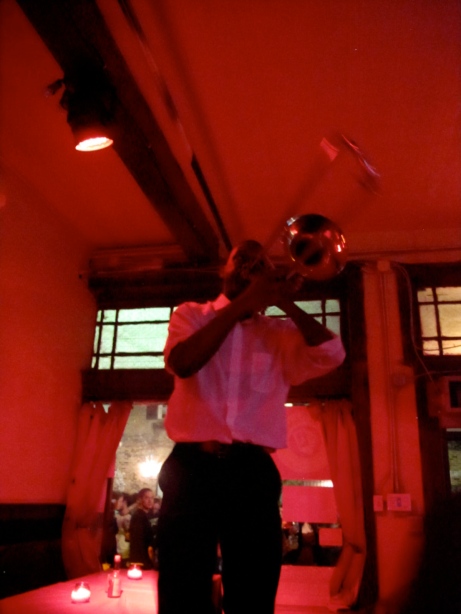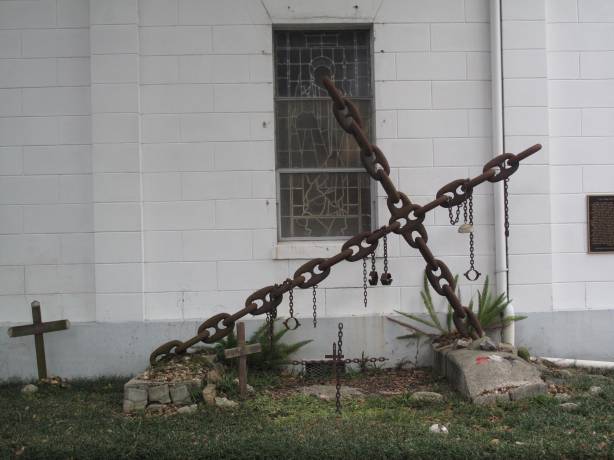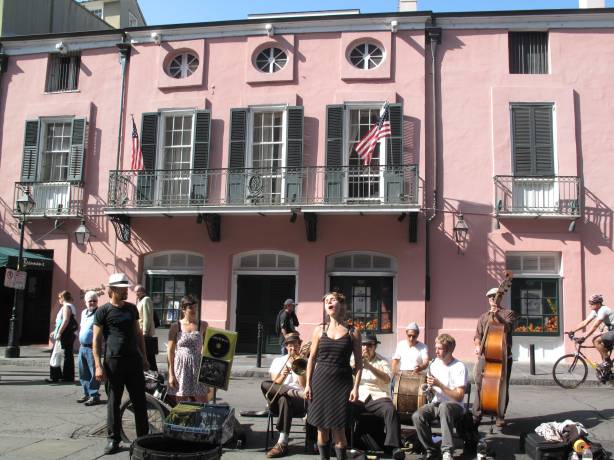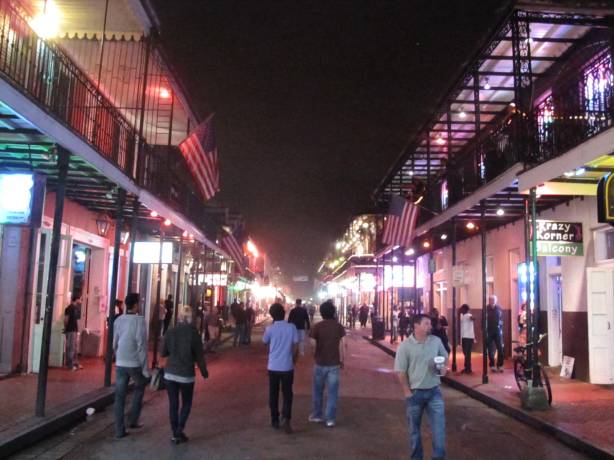Of course there’s a piano in the toilet – it’s New Orleans!
It’s hard to convey New Orleans in a nutshell or in a blog post, for that matter. Before my recent soujourn in the Big Easy, I scoured travel guides and picked the brains of friends who know the city well. I knew a smattering of facts about NOLA’s food, music, and its people, but in all honesty the bulk of my experience was, like many, sound bytes and news clips of the devastation wrought by and deep-seated inequalities unearthed by Hurricane Katrina in 2005.
Still, in the wake of a whirlwind week-long trip to the misty, swelteringly hot, melting pot of a city along the banks of the Mississippi River, I found it hard to describe that special something that sets New Orleans apart from the rest of the United States.
Many months later, I’ve finally brought myself to penning some thoughts about the southern centre of all things jazz. I thought I’d do something a little different, and, in lieu of telling you what to think of this mysterious and magnificent corner of the world, let you discover it for yourself, with the aid of my top 5 tips to ensure that you make the most out of your New Orleans trip:
1. Look no further than Frenchman Street for your fix of hoppin’ New Orleans jazz
One could spend an entire trip to New Orleans on Frenchman Street. Bar hopping from jazz club to jazz club through the early hours of the morning, drinking like a New Orleanean (read: knockin’ them back like there’s no tomorrow), and dancing up a storm to everything from old-fashioned New Orleans style big band jazz, or more modern interpretations of popular music, ‘jazzified’. Sure, there are more underground and (arguably) more ‘authentic’ jazz venues further afield – notably, in Treme (see below) – but for those with only one or two days in the city, Frenchman Street provides more than enough variety of ‘flavours’ for those wanting to dip their toes into the infamous NOLA jazz scene.
2. Eat Fresh Seafood…and plenty of it
Whether or not you are a seafood person, you cannot visit New Orleans without trying some of the world class fruits de mer they have on offer. I would even venture to say it might turn a new leaf in the seafood-averse. From crawfish etoufée, to fresh oysters at the famous Acme Oyster Bar, shrimp gumbo, fried oyster po’ boys (the traditional submarine sandwich of New Orleans), or even a fancy dinner at one of New Orleans’ top end seafood restaurants (try GW Fins off Bourbon Street), New Orleans is known for its seafood for a reason, and it’s not to be missed.
3. Venture into Treme
I cannot say enough how much I loved Treme. Nestled just above the tourist-riddled French Quarter, and slightly off-the-beaten-track for its reputation as being somewhat dangerous (at least after dark), historic Treme is the centre of black culture in New Orleans, the birthplace of jazz, the historic home of voodoo, and simply brimming with cultural and historical heritage.
If you’re sick of the Creole and Cajun-spiced food of the French Quarter, look no further than Treme for a hearty dose of deep Southern Soul Food. For a self-confessed Fried Chicken Addict in need of some finger-lickin’ rehab, Willie Mae’s offered the real deal in terms of golden-encrusted, succulent poultry goodness, as well as other Soul Food staples like okra, mac n’ cheese, fried catfish, black eyed peas and collard greens. For a more up-market Soul Food (wear your Sunday best!), head to the world-famous Dooky Chase for a kickin’ buffet (including more fabulous fried chicken!) that even President Obama has sampled at one point!
Treme is also brimming with the history of slavery in the Deep South, with an interesting Cajun/Creole twist. strong French cultural influence in New Orleans permeates its architecture, food, and laid back nature (where the strong puritan ethic of northern states has never quite taken hold – at least as concerns partying and kicking back), but also its history, where for the longest time French civil law dominated and affected all forms of social life including the lives of slaves.
The more economic versus puritanical motives behind French versus Anglo-American slave systems meant that slaves were given Sunday’s off to congregate in Congo Square, the birthplace of jazz. This slightly more lax attitude towards slaves under the French legal system in New Orleans birthed a vibrant jazz culture which might not have happened under the more work-driven, church-focused and puritanical Anglo south.
Beyond the history of slavery and jazz, New Orleans black culture is unique for its intriguing collision with native American culture, manifested notably in the tradition of Mardi Gras Indians. There are around 40 Mardi Gras Indian tribes comprised of various standard ranks from spyboy up to Big Chief, and the members of these tribes ‘Mask Injun’ for annual parades – meaning they don their native-American inspired costumes to march in a parade, followed by second line jazz details .
The ostentatious costumes, adorned with all manner of bling, and which take a year to hand-sew bead-by-bead (it’s only the African-American men who sew the costumes!), are on display in the Backstreet Cultural Museum. The affable owner/patron/curator of the Backstreet museum, Sylvester Francis, will happily take the time to walk you through the collection and share his intimate knowledge of these traditions, in which he has played a long-standing part.
4. Wander every street in the French Quarter
Opinion on New Orleans tourism generally divides over one issue: Bourbon Street. The infamous street is on the top of many-a-tourist’s list and yet most are surprised to find a Las Vegas style level of garishness when they happen upon the strip joints and neon of Bourbon Street, with more Sean Paul than Miles Davis pouring from its seedy façades.
That said, Bourbon Street has its share of hidden gems, too. Afore-mentioned up-market seafood restaurant G W Fins can be found on an alleyway just off Bourbon Street. Cafe Beignet on Bourbon Street makes a decent version of the famous cinnamon donut-style traditional New Orleans Beignet, and a decent coffee to boot.
There is something to be said for sauntering down Bourbon Street late at night to poke fun at the drunken tourists partaking in debaucherous acts, or trying to spot the most ridiculous outfit. If you have a few days to spend, why not swallow your cynicism vis-a-vis the less picturesque, more garish side of the city and throw it in with the locals for a glass of Wild Turkey on Bourbon Street?
5. Indulge in a little supernatural activity
One of the most striking things I found about New Orleans was the incredible sense of spirituality and the supernatural permeating the air. From the ghosts of the jazz legends felt in the sometimes speakeasy-like jazz bars, to the history of the slaves and free people of color found wandering the streets of Treme, to the old-worldly streetcars which make you want to channel Tennessee Williams and scream “STELLA” at the top of your lungs, to the infamous voodoo queen Marie Levau and her legacy documented in the voodoo museum in the French Quarter, there is no shortage of spooky stories and harrowing history in New Orleans.
The boarded up and torn down houses still dotting some of the Katrina-affected streets are even more a reminder of the history – and the ghosts – that haunt the southern city. Whether you are superstitious, spiritual or a hardened cynic, it is worth visiting the voodoo museum to write down your wish and deliver it to the voodoo statue, to take the streetcar past the cemetery to contemplate the personalities and historic figures who have come before in the city, and to generally be brave enough to wander the streets of the French Quarter on a quintessentially foggy New Orleans evening.
That, or there’s many-a-ghost-tour-operator who’d love to accompany the less brave amongst us for a spooky walking tour of the city’s creepy past.
So there you have it: my top 5 tips for making the most out of your trip to this most fascinating and exhilerating of American cities. I will one day (god-willing) go back for Mardi Gras to experience the sweltering Southern melting pot in all its glory, but in the meantime look forward to hearing your tips, too, so I can collect these for what I hope will be many more visits in future!

Jessica Sinclair is a freelance writer, travel nut, international affairs specialist, and enthusiast for all things global. Having grown up in New Zealand, England, Borneo and Australia, and with family scattered across the globe, Jessica developed from her youngest years an in-built sense of wanderlust and a desire to see more of the world.
During and on completion of her Master of International Studies in Geneva, Switzerland, Jessica has continued to wander the globe for inspiration and edification, in amongst working on project development for non-profit organisations in developing countries. Her stories and articles attempt to bring cultural understanding and unique ‘insider’ angles to the places she visits, and to broader musings for the seasoned voyager, burrowing to the core of what it really means to travel.































